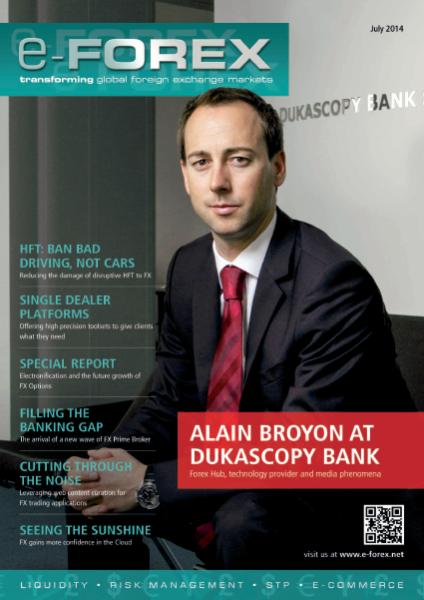EForex Magazine
Post on: 11 Апрель, 2016 No Comment

David Gershon
There is a real need to make the derivative pricing process as simple and at the same time as accurate as possible says David Gershon.
Although there are many sophisticated and knowledgeable participants on the buyside, there is a real need to make the derivative pricing process as simple and at the same time as accurate as possible.
In the past few years, many buyside treasury departments have recognised the great saving potentials that are available through using better tailored hedging. As a result, many have started to use derivatives. Yet, managing derivatives against expected cash flows requires the buyside to be better tuned to the pricing and ongoing revaluations of derivatives.
A problem is that many buyside participants have to look at their risk across a number of different asset classes. So while a sellside trader might be a specialist in foreign exchange, his counterparty on the corporate side may well have to consider how best to manage his risk in currencies, fixed-income and money market products and in some cases even equities.
This emphasizes just how important it is for the buyside to have the tools, which allows it to price and revalue derivatives accurately, quickly and most importantly simply. In the past, buyside hedgers were often faced with stark choices when it came to pricing derivatives. Either they accepted at face value the theoretical prices provided by most systems, which virtually all market participants recognise as being an indicative price only, or they could call several sellside institutions to find out where they would be willing to deal with them.
While this process was likely to have ultimately thrown up a value that is close to the real market price, it presented several problems. The first was that to ring around to ask several banks for the pricing of different strategies was time consuming.
When the moment came to pull the trigger to initiate a trade, the best price may well have changed. If the deal was struck, the buyside participant then probably had only a single counterparty to go back to when it came to unwind the trade.
Furthermore, many buyside participants may have felt embarrassed about ringing banks constantly just to check where the market was. It is not too far fetched to think that poor hedges have resulted as a result of corporate treasurers not wishing to make nuisances of themselves by constantly asking for updates. The success of the electronic trading of spot currencies and bonds shows how greatly price transparency is needed to the buyside and that liquidity increases when this is introduced. The next step is to take derivatives to a similar level.
The sellside has already done a lot to speed the process. Several banks provide free derivative pricing systems to their clients. But it is an old adage that you do not get anything for nothing and this leads into the issue of independence of pricing.
Systems are given away by the sellside because there is a belief that customers become loyal, or less choosy about where they do their trades. As a concept this seems very close to the issue of soft commissions, where data terminals are provided for nothing in return for business.
SuperDerivatives’ buyside customers frequently cite the independence of pricing as a major factor in their decisions to purchase licences, rather than just use systems they are given for nothing. They view access to independent and accurate prices as important for several reasons.
The first is that buyside users of independent and accurate pricing systems can check an option price or strategy as and when they want without interference. When they have formulated what trade they want to do, they can then obtain the best price from their banks because they have ascertained what the true fair value of the option is.
Knowing what an option’s true fair value is means that buyside users can extract fairer prices from their option providers. But it also makes the dealing process more efficient, as the buyside trader does not need to continually check prices.

The introduction of greater transparency to the buyside will encourage greater use of derivatives. The sellside will also benefit as volumes increase and at the same time, the banks will be able to devote more time to suggest efficient strategies to clients.
There is also the issue of marking-to-market as required by accounting standards such as FAS 133 and IAS 39. In order to maintain high quality hedging, the buyside needs to be able to accurately revalue its derivatives portfolio on a day-to-day basis; therefore, it needs access to the fair market prices. Making these prices available electronically is a good solution.
To accurately mark-to-market, it is obviously essential that the pricing system used for revaluation purposes can provide true market rates. Unfortunately, the many systems that rely on Black-Scholes type models cannot provide this required accuracy.
Let us consider a simple example. A US importer has currency exposure equivalent to $50 million in Japanese yen and $30 million in Mexican peso. The corporation chooses to hedge with vanilla options. It buys a USD put and finances it with a USD call, a strategy often called a risk reversal, or cylinder.
The corporation has easy access to the at the money (ATM) volatility in USD/JPY and USD/MXN, but it will still have difficulties to first evaluate the strikes that will produce the zero cost hedge, and later to evaluate the two strategies. This is because different strikes trade at different volatilities, which is known as the volatility smile’.
As can be seen from chart 1, in the case of USD/JPY the difference between using the ATM volatility and the market volatility for the zero cost strikes is around 0.30%. Using the example above, this means that the option price indicated by Black-Scholes pricing systems will be wrong by $150,000. It is even worse with the USD/MXN options, where using the implied ATM vol results in an error in pricing of around 1.0%, or $300,000.
www.e-forex.net/Digital+Versions.efx














